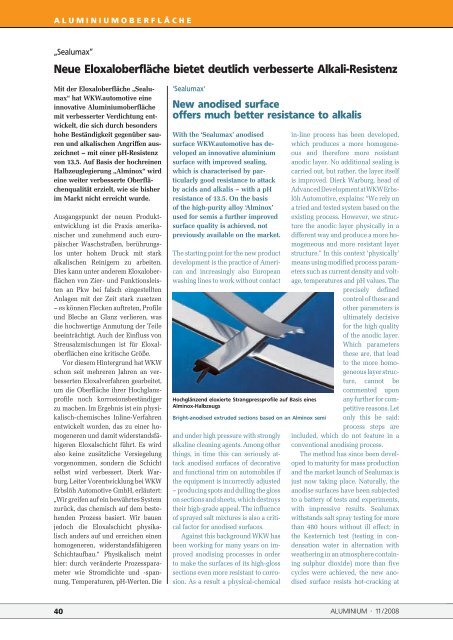SPecIAL - Alu-web.de
SPecIAL - Alu-web.de
SPecIAL - Alu-web.de
Create successful ePaper yourself
Turn your PDF publications into a flip-book with our unique Google optimized e-Paper software.
A L U M I N I U M O b e r f L ä c h e<br />
„Sealumax“<br />
Neue eloxaloberfläche bietet <strong>de</strong>utlich verbesserte Alkali-resistenz<br />
Mit <strong>de</strong>r Eloxaloberfläche „Sealumax“<br />
hat WKW.automotive eine<br />
innovative <strong>Alu</strong>miniumoberfläche<br />
mit verbesserter Verdichtung entwickelt,<br />
die sich durch beson<strong>de</strong>rs<br />
hohe Beständigkeit gegenüber sauren<br />
und alkalischen Angriffen auszeichnet<br />
– mit einer pH-Resistenz<br />
von 13,5. Auf Basis <strong>de</strong>r hochreinen<br />
Halbzeuglegierung „Alminox“ wird<br />
eine weiter verbesserte Oberflächenqualität<br />
erzielt, wie sie bisher<br />
im Markt nicht erreicht wur<strong>de</strong>.<br />
Ausgangspunkt <strong>de</strong>r neuen Produktentwicklung<br />
ist die Praxis amerikanischer<br />
und zunehmend auch europäischer<br />
Waschstraßen, berührungslos<br />
unter hohem Druck mit stark<br />
alkalischen Reinigern zu arbeiten.<br />
Dies kann unter an<strong>de</strong>rem Eloxaloberflächen<br />
von Zier und Funktionsleisten<br />
an Pkw bei falsch eingestellten<br />
Anlagen mit <strong>de</strong>r Zeit stark zusetzen<br />
– es können Flecken auftreten, Profile<br />
und Bleche an Glanz verlieren, was<br />
die hochwertige Anmutung <strong>de</strong>r Teile<br />
beeinträchtigt. Auch <strong>de</strong>r Einfluss von<br />
Streusalzmischungen ist für Eloxaloberflächen<br />
eine kritische Größe.<br />
Vor diesem Hintergrund hat WKW<br />
schon seit mehreren Jahren an verbesserten<br />
Eloxalverfahren gearbeitet,<br />
um die Oberfläche ihrer Hochglanzprofile<br />
noch korrosionsbeständiger<br />
zu machen. Im Ergebnis ist ein physikalischchemisches<br />
InlineVerfahren<br />
entwickelt wor<strong>de</strong>n, das zu einer homogeneren<br />
und damit wi<strong>de</strong>rstandsfähigeren<br />
Eloxalschicht führt. Es wird<br />
also keine zusätzliche Versiegelung<br />
vorgenommen, son<strong>de</strong>rn die Schicht<br />
selbst wird verbessert. Dierk Warburg,<br />
Leiter Vorentwicklung bei WKW<br />
Erbslöh Automotive GmbH, erläutert:<br />
„Wir greifen auf ein bewährtes System<br />
zurück, das chemisch auf <strong>de</strong>m bestehen<strong>de</strong>n<br />
Prozess basiert. Wir bauen<br />
jedoch die Eloxalschicht physikalisch<br />
an<strong>de</strong>rs auf und erreichen einen<br />
homogeneren, wi<strong>de</strong>rstandsfähigeren<br />
Schichtaufbau.“ Physikalisch meint<br />
hier: durch verän<strong>de</strong>rte Prozessparameter<br />
wie Stromdichte und spannung,<br />
Temperaturen, pHWerten. Die<br />
‘Sealumax’<br />
New anodised surface<br />
offers much better resistance to alkalis<br />
With the ‘Sealumax’ anodised<br />
surface WKW.automotive has <strong>de</strong>veloped<br />
an innovative aluminium<br />
surface with improved sealing,<br />
which is characterised by particularly<br />
good resistance to attack<br />
by acids and alkalis – with a pH<br />
resistance of 13.5. On the basis<br />
of the high-purity alloy ‘Alminox’<br />
used for semis a further improved<br />
surface quality is achieved, not<br />
previously available on the market.<br />
The starting point for the new product<br />
<strong>de</strong>velopment is the practice of American<br />
and increasingly also European<br />
washing lines to work without contact<br />
Hochglänzend eloxierte Strangpressprofile auf Basis eines<br />
Alminox-Halbzeugs<br />
Bright-anodised extru<strong>de</strong>d sections based on an Alminox semi<br />
and un<strong>de</strong>r high pressure with strongly<br />
alkaline cleaning agents. Among other<br />
things, in time this can seriously attack<br />
anodised surfaces of <strong>de</strong>corative<br />
and functional trim on automobiles if<br />
the equipment is incorrectly adjusted<br />
– producing spots and dulling the gloss<br />
on sections and sheets, which <strong>de</strong>stroys<br />
their highgra<strong>de</strong> appeal. The influence<br />
of sprayed salt mixtures is also a critical<br />
factor for anodised surfaces.<br />
Against this background WKW has<br />
been working for many years on improved<br />
anodising processes in or<strong>de</strong>r<br />
to make the surfaces of its highgloss<br />
sections even more resistant to corrosion.<br />
As a result a physicalchemical<br />
inline process has been <strong>de</strong>veloped,<br />
which produces a more homogeneous<br />
and therefore more resistant<br />
anodic layer. No additional sealing is<br />
carried out, but rather, the layer itself<br />
is improved. Dierk Warburg, head of<br />
Advanced Development at WKW Erbslöh<br />
Automotive, explains: “We rely on<br />
a tried and tested system based on the<br />
existing process. However, we structure<br />
the anodic layer physically in a<br />
different way and produce a more homogeneous<br />
and more resistant layer<br />
structure.” In this context ‘physically’<br />
means using modified process parameters<br />
such as current <strong>de</strong>nsity and voltage,<br />
temperatures and pH values. The<br />
precisely <strong>de</strong>fined<br />
control of these and<br />
other parameters is<br />
ultimately <strong>de</strong>cisive<br />
for the high quality<br />
of the anodic layer.<br />
Which parameters<br />
these are, that lead<br />
to the more homogeneous<br />
layer structure,<br />
cannot be<br />
commented upon<br />
any further for competitive<br />
reasons. Let<br />
only this be said:<br />
process steps are<br />
inclu<strong>de</strong>d, which do not feature in a<br />
conventional anodising process.<br />
The method has since been <strong>de</strong>veloped<br />
to maturity for mass production<br />
and the market launch of Sealumax is<br />
just now taking place. Naturally, the<br />
anodise surfaces have been subjected<br />
to a battery of tests and experiments,<br />
with impressive results. Sealumax<br />
withstands salt spray testing for more<br />
than 480 hours without ill effect; in<br />
the Kesternich test (testing in con<strong>de</strong>nsation<br />
water in alternation with<br />
weathering in an atmosphere containing<br />
sulphur dioxi<strong>de</strong>) more than five<br />
cycles were achieved, the new anodised<br />
surface resists hotcracking at<br />
40 ALUMINIUM · 11/2008
















